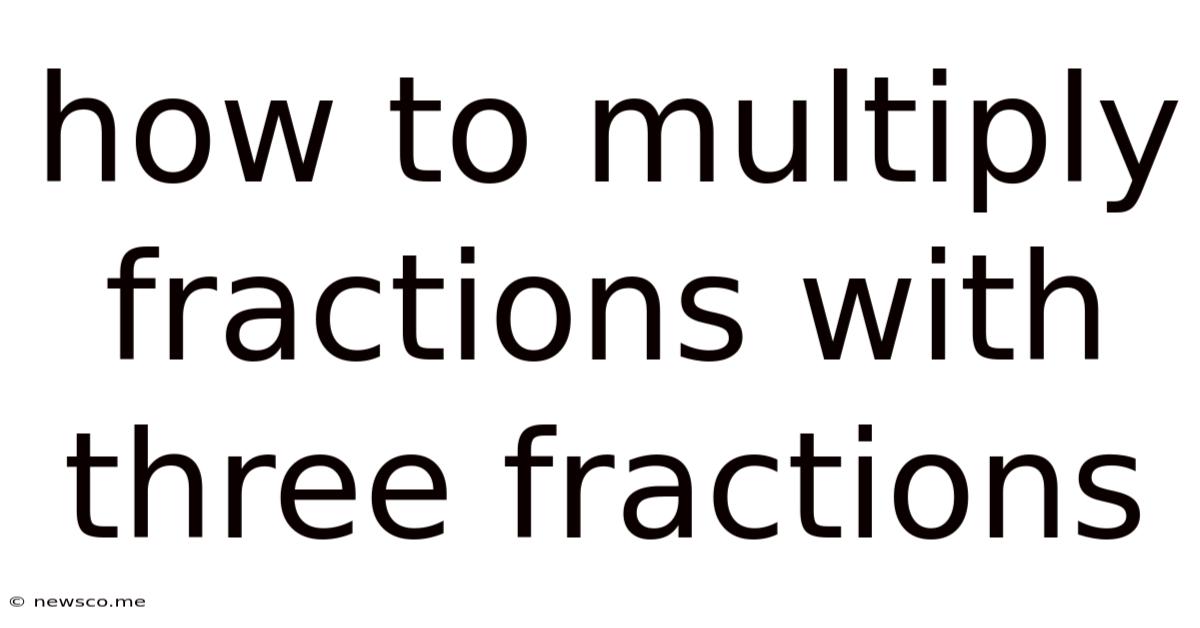How To Multiply Fractions With Three Fractions
News Co
May 08, 2025 · 4 min read

Table of Contents
How to Multiply Fractions with Three (or More!) Fractions: A Comprehensive Guide
Multiplying fractions might seem daunting when you're dealing with more than two, but it's actually a straightforward process once you understand the fundamentals. This comprehensive guide will walk you through multiplying three fractions, expanding to cover multiplying any number of fractions, and even tackling mixed numbers along the way. We'll explore the underlying concepts, provide step-by-step examples, and offer tips and tricks to master this essential mathematical skill.
Understanding the Basics of Fraction Multiplication
Before diving into the complexities of multiplying three fractions, let's review the core principles of fraction multiplication. The fundamental rule is simple: multiply the numerators (top numbers) together and multiply the denominators (bottom numbers) together.
For example, multiplying two fractions:
(1/2) * (3/4) = (1 * 3) / (2 * 4) = 3/8
This same principle applies regardless of how many fractions you're multiplying.
Multiplying Three Fractions: A Step-by-Step Approach
Let's tackle the core topic: multiplying three fractions. The process remains consistent with multiplying two fractions – just expand the process.
Example: Let's multiply (1/2) * (3/5) * (2/7)
Step 1: Multiply the Numerators
Multiply all the numerators together: 1 * 3 * 2 = 6
Step 2: Multiply the Denominators
Multiply all the denominators together: 2 * 5 * 7 = 70
Step 3: Form the Resulting Fraction
Combine the results from steps 1 and 2 to form the final fraction: 6/70
Step 4: Simplify (if possible)
Always simplify your fraction to its lowest terms. Both 6 and 70 are divisible by 2:
6/70 = 3/35
Therefore, (1/2) * (3/5) * (2/7) = 3/35
Multiplying More Than Three Fractions
The process scales linearly – you simply follow the same steps for any number of fractions.
Example: (1/3) * (2/5) * (4/7) * (3/8)
Step 1: Multiply the Numerators: 1 * 2 * 4 * 3 = 24
Step 2: Multiply the Denominators: 3 * 5 * 7 * 8 = 840
Step 3: Form the Resulting Fraction: 24/840
Step 4: Simplify: Both 24 and 840 are divisible by 24. Therefore,
24/840 = 1/35
Incorporating Mixed Numbers
Mixed numbers (like 1 1/2) need to be converted into improper fractions before multiplication. Remember that an improper fraction has a numerator larger than its denominator.
How to Convert a Mixed Number to an Improper Fraction:
- Multiply the whole number by the denominator: (Example: 1 * 2 = 2 for 1 1/2)
- Add the numerator to the result: (Example: 2 + 1 = 3)
- Keep the same denominator: (Example: the denominator remains 2)
Therefore, 1 1/2 becomes 3/2.
Example: (1 1/2) * (2/3) * (1/4)
- Convert the mixed number: 1 1/2 = 3/2
- Multiply the fractions: (3/2) * (2/3) * (1/4)
- Multiply numerators: 3 * 2 * 1 = 6
- Multiply denominators: 2 * 3 * 4 = 24
- Form the fraction: 6/24
- Simplify: 6/24 = 1/4
Therefore, (1 1/2) * (2/3) * (1/4) = 1/4
Cancellation for Simplification: A Time-Saving Technique
Cancellation, also known as cross-cancellation, is a powerful technique to simplify fractions before multiplying. You can cancel out common factors between any numerator and any denominator.
Example: (4/5) * (15/16) * (2/3)
Notice that:
- 4 and 16 share a common factor of 4 (4/16 simplifies to 1/4)
- 15 and 5 share a common factor of 5 (15/5 simplifies to 3/1)
- 2 and 16 share a common factor of 2 (2/16 simplifies to 1/8)
After cancellation:
(1/1) * (3/4) * (1/3) = 1/4
This demonstrates how cancellation can significantly simplify the multiplication process and reduce the need for simplification at the end.
Real-World Applications of Multiplying Fractions
Multiplying fractions is fundamental to many real-world situations:
- Baking: Scaling recipes up or down often involves multiplying fractions.
- Construction: Calculating material quantities frequently requires fraction multiplication.
- Sewing: Determining fabric lengths and pattern adjustments.
- Finance: Calculating portions of a budget or interest rates.
Mastering fraction multiplication equips you to handle these scenarios with ease and accuracy.
Common Mistakes to Avoid
- Forgetting to convert mixed numbers: Always convert mixed numbers to improper fractions before multiplying.
- Incorrect cancellation: Ensure you're only canceling common factors between numerators and denominators, not within the same numerator or denominator.
- Errors in multiplication: Double-check your multiplication of both numerators and denominators to avoid simple calculation mistakes.
- Failing to simplify: Always simplify the resulting fraction to its lowest terms for a complete and accurate answer.
Practice Problems
To solidify your understanding, try these practice problems:
- (2/3) * (5/7) * (1/2)
- (1 1/4) * (2/5) * (3/4)
- (3/8) * (4/9) * (6/5) * (5/12)
- (7/10) * (15/21) * (2/5)
- (2/3) * (4/5) * (1/2) * (15/16)
Conclusion: Mastering Fraction Multiplication
Multiplying three or more fractions is an essential skill with broad applications. By understanding the fundamental principles, utilizing techniques like cancellation, and practicing regularly, you can confidently tackle any fraction multiplication problem. Remember to break down the process into manageable steps, focusing on accuracy and precision. With consistent practice, you’ll develop fluency and expertise in this critical mathematical skill.
Latest Posts
Related Post
Thank you for visiting our website which covers about How To Multiply Fractions With Three Fractions . We hope the information provided has been useful to you. Feel free to contact us if you have any questions or need further assistance. See you next time and don't miss to bookmark.